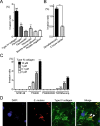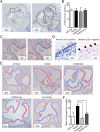Potential involvement of Streptococcus mutans possessing collagen binding protein Cnm in infective endocarditis
- PMID: 33154489
- PMCID: PMC7645802
- DOI: 10.1038/s41598-020-75933-6
Potential involvement of Streptococcus mutans possessing collagen binding protein Cnm in infective endocarditis
Abstract
Streptococcus mutans, a significant contributor to dental caries, is occasionally isolated from the blood of patients with infective endocarditis. We previously showed that S. mutans strains expressing collagen-binding protein (Cnm) are present in the oral cavity of approximately 10-20% of humans and that they can effectively invade human umbilical vein endothelial cells (HUVECs). Here, we investigated the potential molecular mechanisms of HUVEC invasion by Cnm-positive S. mutans. The ability of Cnm-positive S. mutans to invade HUVECs was significantly increased by the presence of serum, purified type IV collagen, and fibrinogen (p < 0.001). Microarray analyses of HUVECs infected by Cnm-positive or -negative S. mutans strains identified several transcripts that were differentially upregulated during invasion, including those encoding the small G protein regulatory proteins ARHGEF38 and ARHGAP9. Upregulation of these proteins occurred during invasion only in the presence of serum. Knockdown of ARHGEF38 strongly reduced HUVEC invasion by Cnm-positive S. mutans. In a rat model of infective endocarditis, cardiac endothelial cell damage was more prominent following infection with a Cnm-positive strain compared with a Cnm-negative strain. These results suggest that the type IV collagen-Cnm-ARHGEF38 pathway may play a crucial role in the pathogenesis of infective endocarditis.
Conflict of interest statement
The authors declare no competing interests.
Figures







Similar articles
-
Potential involvement of collagen-binding proteins of Streptococcus mutans in infective endocarditis.Oral Dis. 2013 May;19(4):387-93. doi: 10.1111/odi.12016. Epub 2012 Sep 24. Oral Dis. 2013. PMID: 22998492
-
CovR and VicRKX Regulate Transcription of the Collagen Binding Protein Cnm of Streptococcus mutans.J Bacteriol. 2018 Nov 6;200(23):e00141-18. doi: 10.1128/JB.00141-18. Print 2018 Dec 1. J Bacteriol. 2018. PMID: 30201780 Free PMC article.
-
The collagen binding protein Cnm contributes to oral colonization and cariogenicity of Streptococcus mutans OMZ175.Infect Immun. 2015 May;83(5):2001-10. doi: 10.1128/IAI.03022-14. Epub 2015 Mar 2. Infect Immun. 2015. PMID: 25733523 Free PMC article.
-
Collagen-binding proteins of Streptococcus mutans and related streptococci.Mol Oral Microbiol. 2017 Apr;32(2):89-106. doi: 10.1111/omi.12158. Epub 2016 Apr 25. Mol Oral Microbiol. 2017. PMID: 26991416 Free PMC article. Review.
-
From Teeth to Body: The Complex Role of Streptococcus mutans in Systemic Diseases.Mol Oral Microbiol. 2025 Apr;40(2):65-81. doi: 10.1111/omi.12491. Epub 2025 Jan 27. Mol Oral Microbiol. 2025. PMID: 39865888 Review.
Cited by
-
New insights into iron uptake in Streptococcus mutans: evidence for a role of siderophore-like molecules.Arch Microbiol. 2025 Mar 20;207(4):96. doi: 10.1007/s00203-025-04284-5. Arch Microbiol. 2025. PMID: 40111578
-
Risk Assessment of Cnm-Positive Streptococcus mutans in Stroke Survivors (RAMESSES): Protocol for a Multicenter Prospective Cohort Study.Front Neurol. 2022 May 12;13:816147. doi: 10.3389/fneur.2022.816147. eCollection 2022. Front Neurol. 2022. PMID: 35645961 Free PMC article.
-
Involvement of the Streptococcus mutans PgfE and GalE 4-epimerases in protein glycosylation, carbon metabolism, and cell division.Glycobiology. 2023 Apr 19;33(3):245-259. doi: 10.1093/glycob/cwad004. Glycobiology. 2023. PMID: 36637425 Free PMC article.
-
Associations between dental caries and systemic diseases: a scoping review.BMC Oral Health. 2021 Sep 25;21(1):472. doi: 10.1186/s12903-021-01803-w. BMC Oral Health. 2021. PMID: 34563194 Free PMC article.
-
Gene Rearrangement and Modification of Immunity Factors Are Correlated with the Insertion of Bacteriocin Cassettes in Streptococcus mutans.Microbiol Spectr. 2022 Jun 29;10(3):e0180621. doi: 10.1128/spectrum.01806-21. Epub 2022 May 23. Microbiol Spectr. 2022. PMID: 35604175 Free PMC article.
References
-
- Roberts GJ, Lucas VS, Omar J. Bacterial endocarditis and orthodontics. J. R. Coll. Surg. Edinb. 2000;45:141–145. - PubMed
Publication types
MeSH terms
Substances
LinkOut - more resources
Full Text Sources
Medical

